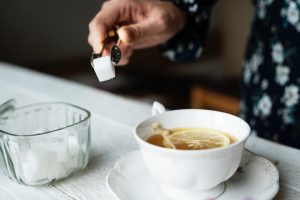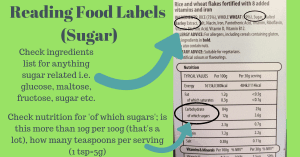 How Much Sugar is Too Much?
How Much Sugar is Too Much?
At the beginning of the year a news story was circulating about the amount of sugar consumed by children between the ages of 2 and 10 years. I was asked to comment on both radio and TV about this story.
The headline “Children in the UK exceed the maximum recommended sugar intake for an 18-year-old by the time they are 10”!
With efforts being made to highlight the sugar issue as well as the infamous ‘sugar tax’ and other Government led initiatives I thought it would help you to know – how much is too much!?
We all know sugar is NOT a health food. It isn’t full of nutrition, and excess consumption is not associated with great health.
The problem is that sugar is everywhere. It’s naturally occurring. It’s also added to just about every processed food there is. And this “added sugar” is a factor in many chronic diseases we see today.
Sugar is inflammatory. Too much is associated with weight gain, diabetes, heart disease, cancer, and cavities. Too much sugar is a huge health risk, no matter how you look at it.
So, let’s talk about how much sugar is “too much.”
Added (free) sugar vs. naturally occurring sugar. What do some of the officials say?
Before we talk about the “official” numbers, you need to know the difference between “added” sugar and “naturally occurring” sugar.
Fruit and other healthy whole foods contain naturally occurring sugar. They also contain water, fibre, vitamins, minerals, and other phytochemicals. They are good for you. Eating fruits and vegetables is a well-proven way to reduce your risks of many chronic diseases.
“Added (or free) sugars,” on the other hand, are concerning. In 2015, a study concluded that 184,000 adult deaths per year were due to the consumption of sugary drinks.
We know that 1 in 3 children going to secondary school are overweight or obese.
We know that we have a big problem and that diabetes is crippling the NHS!
“Added sugars” are also found in biscuits, cakes, sweets, soups, sauces and other processed foods (you might also be surprised to find them in crisps, pizza, bread, yoghurts and stock cubes).
You can find sugar on the ingredient list as many names, often ending in “-ose.” These include glucose, fructose, sucrose, etc.
So, “Total sugars” = “Naturally occurring sugars” + “Added (free) sugars.”
The problem is that our food labels do not give us a breakdown between the natural sugars and the added sugars! How frigging unhelpful is that?
Government guidelines for sugar consumption
Adults should have no more than 30g of free sugars a day, (roughly equivalent to 7 sugar cubes). Children aged 7 to 10 should have no more than 24g of free sugars a day (6 sugar cubes). Children aged 4 to 6 should have no more than 19g of free sugars a day (5 sugar cubes).
The current average intakes are in fact around 15 teaspoons a day for child and 12 teaspoons a day for an adult. That is why we have such a major problem!
How to read the food labels
You need to look at the list of ingredients and find ANY words that are sugar related.
Then you need to look at the food label to see how much of the product is actually sugar.
Then you need to make the decision whether it is a good idea to eat it!
If a product contains only natural sugars i.e. from dried fruit, then this is going to be much for you then a product with added/free sugars. However, you must also consider that natural sugar is still a sugar and therefore need to be limited.
It is certainly not easy!
Take a yoghurt as an example:
Natural plain yoghurt will contain naturally occurring milk sugars. But add some fruit to the yoghurt and you suddenly see sugar added as an extra ingredient along with the fruit (I’ve never understood this!!!). So, in order to avoid the added sugar, it is better to opt for a natural yoghurt and add the fruit yourself.
Fruit juice is extremely contentious. Kids love juice and it does contain vitamins (if you are buying a good quality fresh juice). The problem with this, is that it doesn’t contain the fibre and so when consumed it gives the body a huge sugar rush. This doesn’t happen with vegetables juices.
My advice is always to dilute fruit juice with at least 50% water. Avoid giving babies and young kids juice for as long as possible. And finally give them a very small glass or beaker WITH their food.
But what about squash I hear you cry?
The are two problems with squash:
1) They either contain lots of sugar, or
2) They contain lots of artificial sugars (another entire blog post)
I do not give my kids squash – they have water!
What is a better daily sugar goal?
While the official numbers are a step in the right direction, they’re not entirely helpful!
A better way to reduce your sugar intake is to ditch as many processed foods as possible, regardless of their sugar content. There are a ton of studies that show that processed foods are bad for your health.
I wouldn’t recommend eating your “daily amount” of sugar from sweetened processed foods.
Get your sugar from whole, unprocessed fruits first.
Start looking at the foods you use regularly that come in a packet, tin or box. Is there a better alternative? You will have to read the food labels. Can you make some of these yourself as a healthier option?
Write a food diary for a week and see how many foods contain sugar. This is a good exercise to do with your kids.
You may be shocked by how much sugar is in the school dinners!!!
Tips to reduce your sugar intake
Here are some of my most popular recommendations to reduce your sugar intake, so you don’t get too much:
● Reduce (or eliminate) sugar-sweetened beverages; this includes fizzy drinks, sweetened coffee/tea, sports drinks, etc. Instead, have fruit-infused water. Or try drinking your coffee/tea “black” or with a touch of cinnamon or vanilla instead.
● Reduce (or eliminate) your desserts and baked goods and bake your own instead. You can easily reduce the sugar in a recipe by half.
● Instead of a granola bar (or other sugary snack), try fruit, a handful of nuts, or veggies with hummus. These are easy grab-and-go snacks if you prepare them in a “to-go” container the night before.
● Start changing one product at a time and get used to reading the food labels.
● Use the change for life app which you can use to scan a product to see exactly how much sugar it contains.
If you need help to overhaul your families diet click HERE.
References:
https://www.bbc.co.uk/news/health-46720303
https://www.theguardian.com/society/2015/oct/23/sugar-britains-obesity-crisis-key-questions-answered
https://www.gov.uk/government/news/guidelines-on-reducing-sugar-in-food-published-for-industry
https://www.nhs.uk/live-well/eat-well/how-does-sugar-in-our-diet-affect-our-health/
https://authoritynutrition.com/how-much-sugar-per-day/
http://www.precisionnutrition.com/truth-about-sugar
http://www.health.harvard.edu/staying-healthy/how-to-spot-and-avoid-added-sugar



Leave a Comment